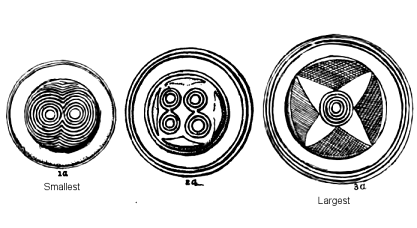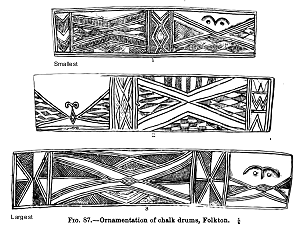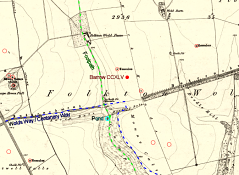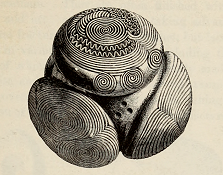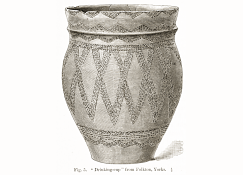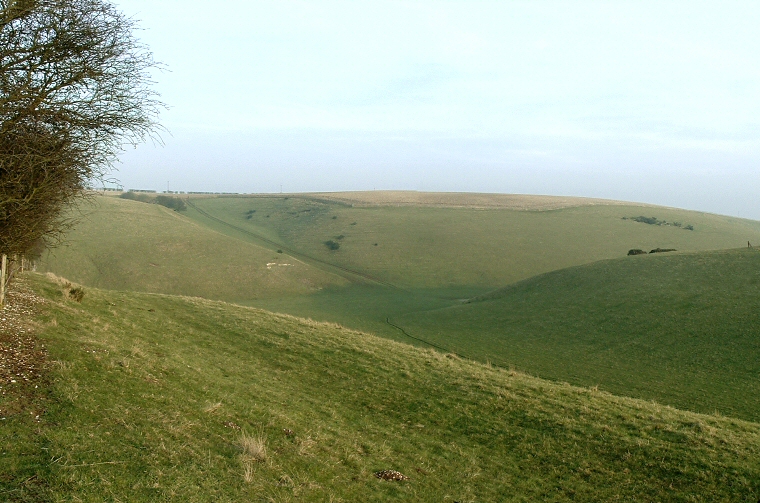 |
There
is nothing left to be seen of the Folkton barrow
today, indeed it was less than a metre high when the antiquarian William Greenwell excavated
it in 1889 and gave it the rather less than memorable label of CCXLV under his own numbering system, but the site is notable for two reasons. 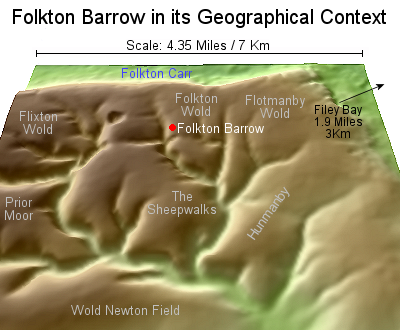 First is the position of the barrow, marked on the 3D elevation model left. As you follow the route of both the Wolds Way and the Centenary Way eastwards from the minor road that runs from Flixton to Fordon it is striking how much the landscape opens out to form a huge natural north to south and east to west crossroads of steep sided valleys, or as they are known locally, dales between the hills (photograph above looking east,
the barrow was on the slopes of the hill on the upper left). The barrow
would have overlooked what could have been an important junction of two
trading routes, indeed both modern walking routes take a turn at the junction and follow the southern valley while a public footpath leads north to the village of Folkton itself. The junction is also marked by a large pond, this is presumably a clay-lined dew pond constructed prior to a map of mid 19th century on which it is shown (thumbnail image near the bottom of the page) but it is just possible it could point to a earlier source of water, a scarce and valuable resource on the chalk uplands of the Yorkshire Wolds. First is the position of the barrow, marked on the 3D elevation model left. As you follow the route of both the Wolds Way and the Centenary Way eastwards from the minor road that runs from Flixton to Fordon it is striking how much the landscape opens out to form a huge natural north to south and east to west crossroads of steep sided valleys, or as they are known locally, dales between the hills (photograph above looking east,
the barrow was on the slopes of the hill on the upper left). The barrow
would have overlooked what could have been an important junction of two
trading routes, indeed both modern walking routes take a turn at the junction and follow the southern valley while a public footpath leads north to the village of Folkton itself. The junction is also marked by a large pond, this is presumably a clay-lined dew pond constructed prior to a map of mid 19th century on which it is shown (thumbnail image near the bottom of the page) but it is just possible it could point to a earlier source of water, a scarce and valuable resource on the chalk uplands of the Yorkshire Wolds. The second reason for the site's importance are the finds from the barrow itself. Buried in an oval grave 90cm long, 46cm wide and 36cm deep was the body of a child accompanied by three small carved chalk cylinders or 'drums' measuring 11.8cm, 10.5cm and 8.6cm tall and with diameters of 14.6cm, 12.7cm and 10.2cm respectively (images below). The smallest drum was found behind and in contact with the child's head while the two larger drums had been placed behind and in contact with their hip. A broken bone pin found beside this last pair may have held together the child's cloak or funeral shroud but equally it may have sealed a cloth or leather pouch designed to protect the fragile chalk objects from damage. The three cylinders are now collectively known as the Folkton Drums and are decorated with a series of lines, chevrons, lozenges and geometric shapes, some incised others carved in relief and laid out in discreet zones or panels. There is also a single distinctive motif on each of the drums, two of which, on the smallest and largest drums, could be interpreted as eyebrows and eyes (to the left and right below) while the third is perhaps more abstract but may represent eyebrows, a mustache or the antennae of a butterfly. A recent re-examination of the drums has shown a further erased 'eyebrow' carving above the existing motif on this third drum. All three of these enigmatic carvings are set against plain unmarked backgrounds which may have been intended to enhance and draw attention to the motifs, indeed Greenwell regarded them as the principal features of the drums. The two sets of apparent eyes on the smaller and larger drums combined with the lozenge pattern below them, which could be interpreted as a stylised mouth, has led some to interpret the drums as representing idol or deity figures which would imply a ritual symbolism to the objects. The 'face' is particularly striking on the largest drum, below right. Although the tops of the drums appear to form lids, they are in fact solid with each drum featuring a different motif, this time based around concentric circles. Interestingly the conjoined circles cut into the top of the smallest drum bear more than a passing resemblance to the patterns on some carved stone balls recovered from the north of Scotland and thought to date to the late Neolithic period (thumbnail image of the Towie ball near the bottom of the page). |
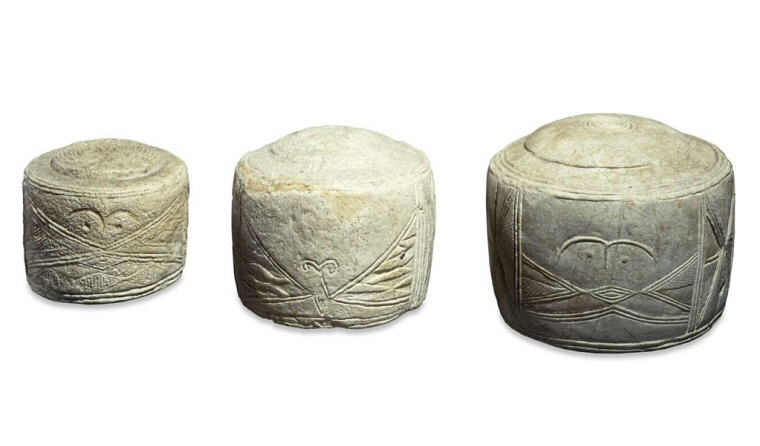 The Folkton Drums © The Trustees of the British Museum. |
| Stylistically the geometric zoning around the sides of the drums recalls some of the elements seen decorating Grooved Ware pottery, a particular development which formed one component part of a 'cultural package' that emerged from the far north of Britain, particularly around Orkney and that spread southwards through most of the British Isles in the late Neolithic, from about 3000 BC onwards. While the drums don't appear to be modeled after any known surviving ceramic items they may however represent copies of contemporary wooden or woven basketry containers. If the Folkton Drums are dated to the late Neolithic by analogy with Grooved Ware pottery then they are at odds with some of the the other finds from within the barrow. Greenwell interpreted a burial under a central cairn of a single male and female accompanied with a decorated beaker (thumbnail image near bottom of page) as the primary interment while he considered the child burial and the drums as belonging to a secondary event. However, the beaker which appears to be a short-necked example belonging to the early Bronze Age, perhaps from about 2300BC onwards, would almost certainly post-date the drums. This suggests that either the drums were heirloom objects that had been carefully curated for several hundred years, which would be remarkable given the fragile nature of chalk, and had survived long enough to be buried with the child or that Greenwell had got his burial sequencing wrong. Doubt on the reliability of the evidence from the the cairn may come from Greenwell's own account of the excavation of the barrow when he states: 'The cairn had been disturbed in modern days, and the bodies taken out and partly returned, the skulls having been removed. The "drinking-cup" also had been replaced, though in a broken condition.' There is no guarantee that the beaker (Greenwell's 'drinking cup') originally came from within the cairn, it may have been found elsewhere within the barrow and had then been placed, rather than 'replaced', in the cairn by whoever disturbed the bodies and removed the skulls. Greenwell's other finds from the barrow include a 1.5 metre diameter pit that had been cut to a depth of 1.2 metres into the ground before being backfilled with earth and burnt soil and then covered with a layer of flint. There were no apparent human remains in the pit but he did find five more inhumations within the material of the barrow. The burial of an adult was found just 23cm below ground level while an adult male was found laid on the original ground surface. A further child's burial was located within the barrow just above ground level and finally two adult burials slightly higher in the barrow, one was an adult male found at about 30cm above the original ground level, the other at a height of about 60cm and close to the top of the mound had been scattered by the plough and could not be identified further. Greenwell could find no evidence that the barrow had been dug into to insert any of the bodies which suggests that those recovered from within the barrow material itself had been placed into the mound during its construction and were not later intrusive burials. The bodies could possibly represent a single mass burial event but as Greenwell found the barrow was constructed from alternating layers of 'very dark earth' (possibly from decayed blocks of turf) and thinner layers of chalk rubble it seems plausible that as each successive body had been placed into, or onto, the existing mound they were then covered with a new layer of earth and chalk. As the mound grew in size the chalk rubble may have been added as the outer layer on each occasion to form a striking white exterior to the barrow. Given the finds of the chalk drums and the beaker from the barrow combined with its prominent location and unusual construction, we can perhaps suggest that those buried at the site may represent a dynasty of fairly high status local farmers and landholders. A further investigation of barrow CCXLV by T. Brewster in 1969 (which apparently remains unpublished in a completed form) can perhaps shed more light on the history of the site. Brewster uncovered another complete child burial, this time wearing a necklace of 160 beads of Whitby jet and accompanied by two beakers placed behind their shoulder, clearly another high status burial. Another child's skull was also found in the same grave along with what may have been a bone belt ring. He also found several other features that were apparently missed by Greenwell, one was a hearth with evidence of burning just to the east of the 'drum' burial, a pit containing earth and charcoal and covered with flint blocks, two more pits containing just earth and a small pit or post-hole covered with burnt stones and containing two Neolithic pottery sherds and several pieces of struck flint. A final pit that was assumed to be the one recorded by Greenwell was re-examined and found to contain animal bones and traces of charcoal. Within the barrow material and spoil from the plough were sherds of both Neolithic and Bronze Age pottery as well as several flint tools and flint cores. Together these would suggest that before the decision was taken to begin the construction of a barrow the hillside had already long been a focus of activity, witnessing repeated episodes of pit digging, some of which may have been associated with feasting as well as the interment of bodies over many years, perhaps spanning the period of the late Neolithic and into the early Bronze Age. The child buried the with chalk drums was presumably one of the earliest events. The Folkton Drums were donated to the British Museum in London by Greenwell although a set of replicas can be seen in the excellent Hull Museum. |
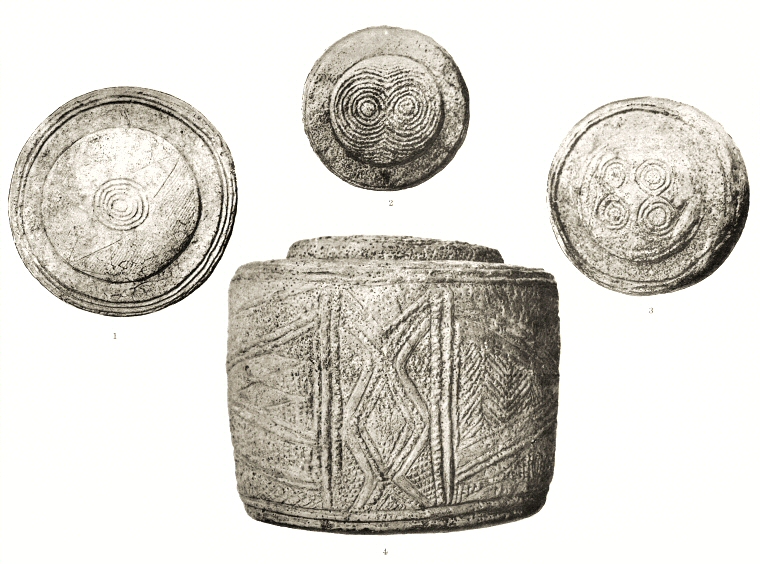 The Folkton Drums, image from Greenwell 1890, Plate 1. The side view is of the smallest drum. |
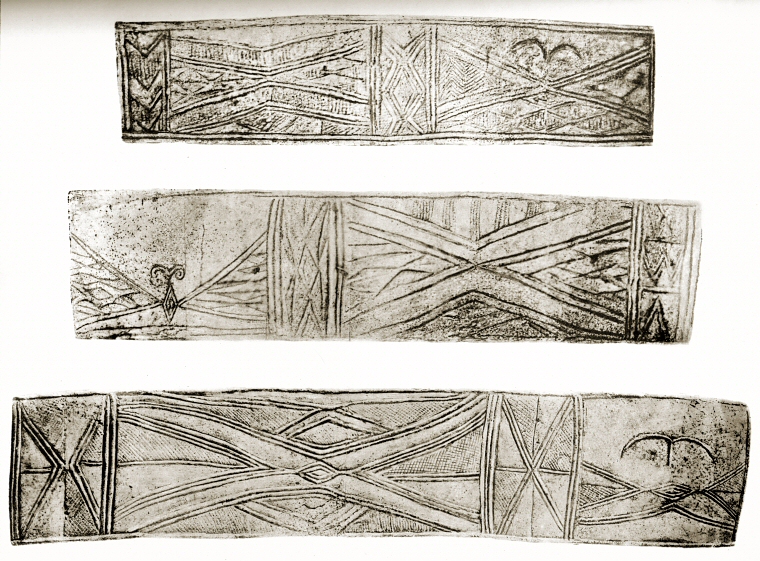 The Folkton Drums, image from Greenwell 1890, Plate 2. An expanded view of the three drums. Note the apparent human faces on the right hand side of the top and bottom drum. |
Update: The Lavant Drum The Folkton Drums were long considered to be a unique find until a similar 'drum' was unearthed in 1993 at Lavant in Sussex. The Lavant Drum measures 10.5cm tall and has a diameter of 11.5cm but unlike its Folkton equivalents it appears to be unfinished with a very rough appearance and with very little decoration apart from a few incised lines and scratches. The drum is tentatively dated to about 3000BC by association with Neolithic Mortlake pottery found nearby. Update: February 2022, The Burton Agnes Drum Remarkably, although perhaps now not unsurprisingly, yet another of these enigmatic carved objects has just come to light. An elaborately marked 'drum' was recovered during a dig prior to the construction of a biogas plant on the Burton Agnes estate just under 9 miles (14km) to the west-southwest in East Yorkshire. Although the item is said to have been found in 2015 it has taken 7 years for the announcement to be made public (in some archaeological circles this would be regarded as indecent haste). Found in association with the burial of three children the drum is stylistically strikingly similar to the Folkton Drums, in the photograph below the diagonal cross motif, or saltire, with a lozenge feature in the middle is almost identical to that in the bottom expanded view of the largest Folkton Drum shown above. However while the Folkton carvings feature three different variation of circular motifs on their 'lids', the Burton Agnes example is marked with a cross figure. Three holes also drilled into the top of the drum are unexplained but archaeologists have suggested this might relate to the number of the children buried in the grave. Given the similarity of the Burton Agnes and Folkton objects it would seem that they were all carved to a standard template and with a set of prescribed motifs. Also given the proximity of the two find sites it is tempting to suggest that they came from the same 'workshop' and were possibly carved about the same time.. Radiocarbon analysis of one of the Burton Agnes children's bones suggests they were buried between 3005BC and 2890BC, this date matches well with the Lavant Drum and would strongly suggest a similar date for the carving of the Folkton Drums. |
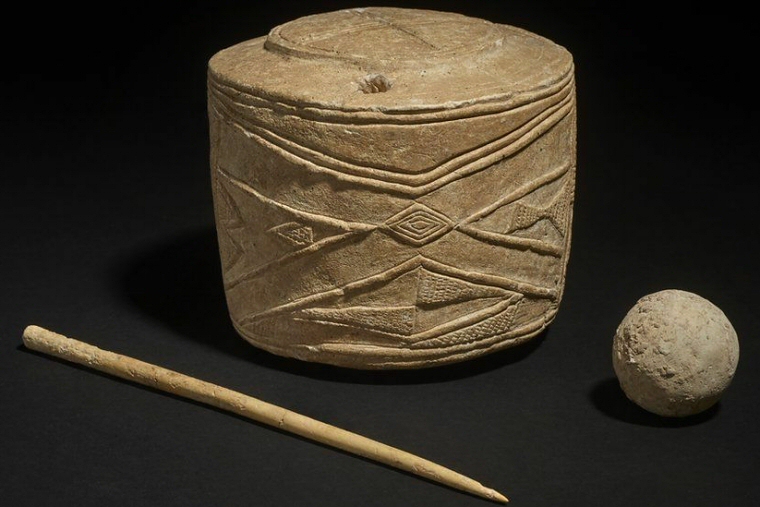 Press release of the carved chalk 'drum' found at Burton Agnes along with a carved chalk ball and bone pin Press release of the carved chalk 'drum' found at Burton Agnes along with a carved chalk ball and bone pin |
Site Visits / Photographs: February 2003. References: Abercromby, J. 1912. A study of the Bronze Age pottery of Great Britain & Ireland... Oxford: Clarendon. BBC. 2022. Ancient chalk sculpture is 'most important prehistoric art'. BBC News. Cooper, M. Hamilton, D. Gibson, A. 2021. Tracing the lines: Scottish Grooved Ware trajectories... PSAS, 150, 81–117. Darvill, T. 2010. Prehistoric Britain. 2nd Edition. Abingdon: Routledge. Gibson, A. 2002. Prehistoric Pottery in Britain and Ireland. Stroud: Tempus. Greenwell, W. 1890. Recent Researches in Barrows in Yorkshire... etc. Archaeologia, Vol 52, 1-72. Heise, M. 2014. Heads North or East? A re-examination of Beaker Burials in Britain. Thesis, (PhD). Uni. Edinburgh. Jones, A. & Díaz-Guardamino, M. 2021. Making a Mark: Process, Pattern and Change... Cam Arch Journal. Manby, T. 1988. The Neolithic in Eastern Yorkshire. In Manby (ed) Archaeology in Eastern Yorkshire... Sheffield: Collis. McLaren, D. 2011. Funerary rites afforded to children in Earlier Bronze Age Britain. Thesis, (PhD). Uni. Edinburgh. Newton, G. 2022. Burton Agnes drum: How a young archaeologist... Yorkshire Post. Read, C. 1904. British Museum - A guide to the antiquities of the Bronze Age... Oxford:. Smith, J. 1874. Notes of Small Ornamented Stone Balls found in ... Scotland PSAS, 11(1), 29-62. Stoertz, C. 1997. Ancient Landscapes of the Yorkshire Wolds. Aerial photographic... Swindon: RCHME. Teather, A. & Kenney, J. 2016. ...Neolithic chalk drums from Folkton ... and Lavant... Past, 83, 5–6. Wilson, D. 1863. Prehistoric Annals of Scotland. Vol 1. Second Edition. London: Macmillan. Woodward, A. 2000. British Barrows. A Matter of Life and Death. Stroud: Tempus Publishing Ltd. Extracts from Historic England Research Records Hob Uid: 79665 National Monuments Record Number: TA 07 NE 8. County Number: NY 820.. |
